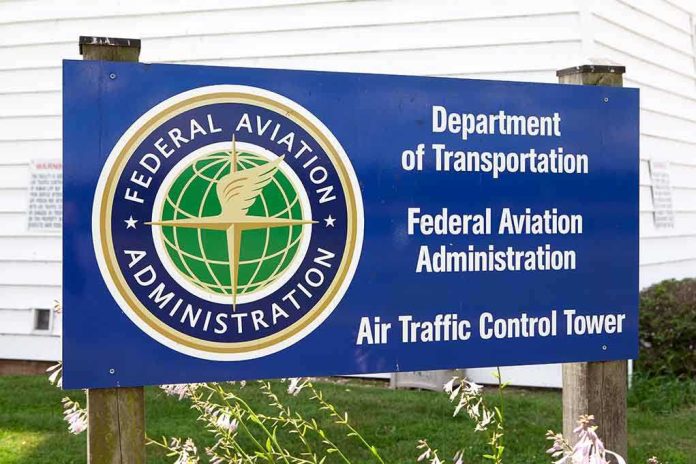
When the government grinds to a halt, America’s air travel system doesn’t just slow—it fractures, sending shockwaves from the busiest airports to the quietest terminals and leaving the nation’s flight attendants warning of a looming crisis that could touch every traveler and community.
Story Snapshot
- Flight attendants warn of nationwide safety and operational “ripple effects” as FAA orders flight cuts at 40 major airports.
- The mandate stems directly from the longest government shutdown in U.S. history, forcing essential aviation staff to work unpaid and under extreme strain.
- Initial cuts of 4% are expanding toward 10%, triggering cascading delays, cancellations, and staff exhaustion that reach far beyond major hubs.
- Regional airports, frontline workers, and local economies all feel the pressure, amplifying calls for urgent resolution and reform.
Government Shutdown Drives the Aviation System to the Brink
Federal gridlock has never felt so tangible as it does in America’s airports this week. The Federal Aviation Administration, under the immense pressure of a record-breaking government shutdown, issued a directive slicing flight schedules at 40 of the nation’s busiest airports. The reason: air traffic controllers and other essential staff are working without pay, with no end in sight. Airlines responded within hours, slashing departures and arrivals, and setting off a domino effect that has already left terminals buzzing with confusion and frustration.
Flight attendants, who see every ripple up close, are sounding the alarm. They warn that the government’s mandate doesn’t simply delay flights—it undermines safety, stretches crew thin, and exposes passengers to unpredictable disruptions. This isn’t just about the major hubs; the shock travels outward, touching regional airports like Fresno Yosemite International, where even a single delayed flight can cascade into chaos for dozens of families and businesses.
Frontline Workers Face Safety Risks and Burnout
Unpaid, overworked, and under immense stress, air traffic controllers and flight attendants find themselves at the epicenter of this crisis. Union leaders have issued stark warnings: the system’s safety net is fraying. As the FAA phases in cuts of up to 10%, the challenge isn’t just rerouting planes—it’s maintaining vigilance in the control tower and composure in the cabin when nerves are stretched to breaking. Airlines, caught between regulatory compliance and customer outrage, scramble to adjust schedules while absorbing mounting financial losses. Flight attendants relay stories of longer shifts, missed breaks, and mounting passenger frustration, while airport authorities urge travelers to check their flights and “pack their patience.”
In Fresno, spokeswoman Vikkie Calderon emphasizes that the disruptions are not isolated; they reflect a network under siege. Canceled flights ripple outward, stranding passengers and upending carefully orchestrated travel plans. For many, the experience is more than an inconvenience—it’s a warning sign that the system’s resilience is evaporating under federal dysfunction.
Ripple Effects Hit Regional Airports and Local Economies
Travelers at regional airports feel the brunt of the ripple effect with particular force. In places like Fresno, where alternative transportation options are limited, a delayed or canceled flight can mean missed business deals, family emergencies prolonged, or critical goods stuck in transit. Local economies, reliant on the constant churn of visitors and commerce, brace for the fallout. Each canceled flight means lost revenue for airports, hotels, restaurants, and taxi drivers. The aviation sector’s interconnectedness magnifies every disruption, proving that no community is immune when the federal government stalls.
Flight attendants and local officials argue that these cascading impacts reveal deeper vulnerabilities in America’s air travel system. Years of underfunding and growing dependence on skilled federal workers have left the sector uniquely exposed to political stalemates. As delays stretch into days and costs mount, the pressure grows on lawmakers to break the deadlock and restore normal operations.
Industry Experts Warn of Long-Term Damage and Policy Shifts
Aviation analysts and transportation scholars describe the current crisis as a stress test for the nation’s airspace. Even small reductions at the wrong nodes can paralyze the network, creating missed connections and compounding delays nationwide. Some industry voices defend the FAA’s cautious approach as necessary for maintaining safety. However, labor advocates counter that the situation spotlights systemic flaws—particularly the risks of relying on essential federal workers without adequate support or contingency planning.
Longer-term, the shutdown’s legacy could reshape the aviation landscape. The public’s trust in air travel reliability erodes with each day of delays and uncertainty. Airlines face lasting financial wounds, while regional economies may struggle to recover lost business. Policy experts predict a reckoning: renewed debates about aviation funding, labor protections, and the balance of power between federal agencies and frontline workers. The crisis offers a stark reminder that America’s skies—and its economy—cannot afford political paralysis. For now, flight attendants continue to raise their voices, hoping that their warnings will not go unheeded as the nation’s airports brace for whatever comes next.







